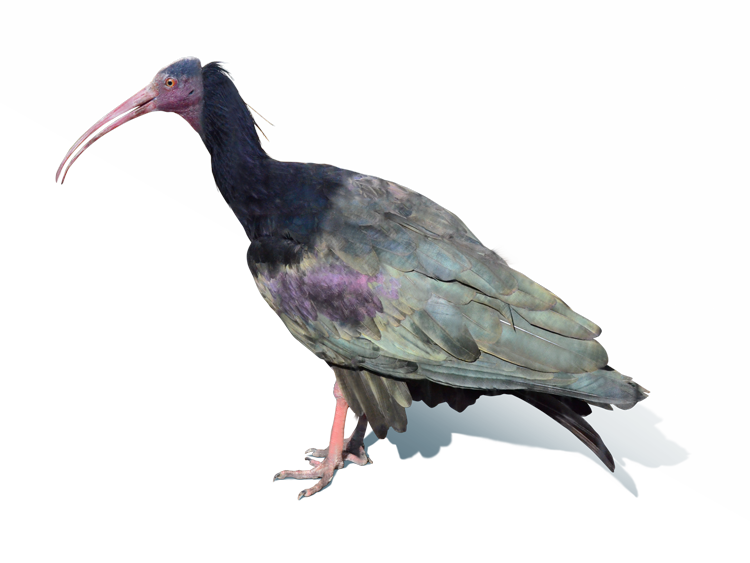
Geronticus eremita (Linnaeus, 1758)
祝福された死者の象徴
The Symbol of the Blessed Dead
全長約80cm、翼長41cm。頭部の肌は赤く露出し、冠羽と首は暗色、羽は緑や紫の金属光沢を帯びるなど、非常に特徴的な姿をしています。かつてホオアカトキは北アフリカから中東、ヨーロッパの一部にまで広く分布していましたが、野生個体は現在モロッコにのみ約700羽(2019年時点)が確認されているにすぎません。草原や半砂漠、岩場など乾燥地帯に生息し、昆虫やトカゲなどの小動物を捕食します。繁殖は崖の出っ張り部分などを利用して行われ、ヨーロッパではかつて古城の城壁や遺跡を営巣地としていた記録も残ります。
属名 Geronticus は古代ギリシャ語で「老人」を意味し、種小名 eremita はラテン語で「荒野に住む隠者」を指します。その名の通り、乾燥地に生きる孤高の鳥です。近縁種はハゲトキ(Geronticus calvus)のみで、両者はハゲトキ属を形成します。この属は他のトキ属と系統的にやや離れた位置にあり、進化的にも貴重な存在です。化石記録によれば、フランスの中新世地層からハゲトキ属に近い原始的トキ類が発見されており、この系統が古くからユーラシアに広がっていた可能性が示唆されています。
古代エジプトでは知恵と書記の神トトがアフリカクロトキの姿で描かれたことが知られていますが、近年の研究でホオアカトキは「アク(akh)」と呼ばれる“祝福された死者”を象徴する鳥として用いられていたことが分かってきました。「アク」は死後に生命力(カー)と魂(バー)が再結合して生まれる光り輝く存在であり、再生と永遠の命を意味します。ホオアカトキがかつてエジプト東岸の崖地に生息していたこと、そしてそこが「再生の地平線(アケト)」と重なることが、この鳥が“帰ってくる死者”の象徴とされた理由と考えられています。
このようにアフリカクロトキとホオアカトキは古代エジプトで神聖な存在であったのですが、アフリカクロトキは神に捧げられた何百万体ものミイラが見つかっているのに対して、ホオアカトキのミイラはほとんど確認されていません。このことは、ホオアカトキが早い段階でエジプトから姿を消したことを示唆しています。
Measuring about 80 cm in length with a wingspan of 41 cm, the Northern Bald Ibis is a striking bird distinguished by its bare red head, dark neck adorned with a crest, and iridescent plumage that shimmers in green and violet hues. Once widespread across North Africa, the Middle East, and parts of Europe, its wild population now survives only in Morocco, with roughly 700 individuals remaining as of 2019. It inhabits dry grasslands, semi-deserts, and rocky plateaus, feeding on insects, lizards, and other small animals. Colonies breed on cliff ledges, and in Europe, the species was once known to nest on castle walls and ancient ruins.
The genus name Geronticus derives from the Greek word for “old man,” while the species name eremita comes from Latin, meaning “hermit” or “dweller of the wilderness.” True to its name, it lives a solitary life in arid landscapes. Its only close relative is the Southern Bald Ibis (Geronticus calvus), and together they form the genus Geronticus, which occupies a phylogenetically distinct position within the ibis family. Fossil evidence from Miocene deposits in France indicates that primitive ibises related to this genus once inhabited Eurasia, suggesting that Geronticus represents an ancient evolutionary lineage.
In ancient Egypt, the god Thoth—deity of wisdom and writing—was often depicted with the head of the African Sacred Ibis (Threskiornis aethiopicus). Recent research, however, suggests that the Northern Bald Ibis symbolized akh, the “blessed spirit of the dead.” The akh represented a luminous being formed when a person’s life force (ka) and soul (ba) reunited after death, embodying rebirth and eternal life. The ibis once inhabited cliffs along Egypt’s eastern desert, geographically aligned with the “horizon of rebirth” (akhet), which may explain its association with resurrection and the return of the dead.
Thus, while both the African Sacred Ibis and the Northern Bald Ibis held sacred status in ancient Egypt, millions of mummified Sacred Ibises have been discovered as offerings to the gods, whereas almost no mummies of the Northern Bald Ibis have been found. This striking absence suggests that the species disappeared from Egypt at an early stage in its history.
参考文献
時事通信社 | 時事ドットコムニュース | 特集 | 歴史の十字路・トルコ南東部 2025年11月1日閲覧
“Saving the Northern Bald Ibis. Birecik, Turkey” Travel to Eat, Kurt Buzard MD. 2025年11月1日閲覧
福田奈央のブログ | ちょっと珍しい古代エジプトネタ42「トキの頭をした神様」| (2025年1月5日) 2025年11月1日閲覧
“Sacred Birds In Ancient Egypt: Ibises, Falcons, Kestrels” Facts and Details. 2025年11月1日閲覧
日本経済新聞 | NIKKEI STYLE | ナショナルジオグラフィック日本語版 | 「永遠の命」を求めて 古代エジプト人がしていたこと | (2022年12月8日) 2025年11月1日閲覧
ナショナルジオグラフィック | ニュース | 古代エジプトに大量の鳥ミイラの謎、異説が浮上 | (2019年11月17日) 2025年11月1日閲覧